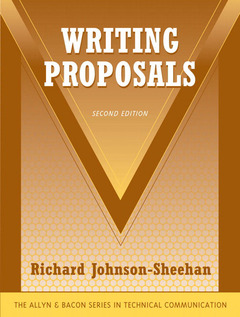Writing proposals (2nd ed ) (2nd Ed.)
Auteur : Johnson-Sheehan Richard

Written for college students or professionals seeking a reference, Writing Proposals offers a comprehensive, strategic approach to proposal development for the technical professions. The author takes readers step-by-step through the development process, helping them invent ideas, organize materials, write in plain and persuasive styles, and create an effective visual design. Writing Proposals provides students with additional material frequently not found in other texts on writing proposals, including a full chapter on creating budgets and thorough coverage of using the Internet.
Preface
Chapter One: Introduction to Proposals and Grants
Why Do We Write Proposals?
Rhetoric
The Proposal Genre
The Proposal Writing Process
Writing Grant Proposals
Case Study: The Cool Campus Project
Chapter Two: Identifying Problems and Opportunities
Two Basic Reasons for Writing Proposals
Unsolicited and Solicited Proposals
Reading RFPs
Determining the Status, or Stasis, of an Opportunity
A Description of the RFP Interpretation Process
Defining the Problem or Opportunity
Applying Stasis Questions
Case Study: What Is The Problem?
Chapter Three: Strategic Planning for Proposals and Grants
Elements of Strategic Planning
Setting Objectives
The Rhetorical Situation
The Situation at Overture Designs
Focusing a Writing Team
Case Study: Defining the Rhetorical Situation
Chapter Four: Describing the Current Situation
Why Describe the Current Situation?
Guidelines for Drafting the Current Situation Section
Researching the Current Situation
Mapping in Teams
Writing the Current Situation Section
Lisa Miller's Current Situation Section
Special Case: Research Grants and Literature Reviews
Case Study: Describing the Current Situation at Durango University
Chapter Five: Developing a Project Plan
The Importance of the Project Plan Section
Setting Objectives for the Project
Setting Goals for the Overture Designs Project
Answering the How Question
Mapping a Project Plan for the Overture Proposal
Organizing the Project Plan Section
Answering the Why Questions
Writing the Project Plan Section
Developing a Project Timeline
A Comment on Research Methodologies
Case Study: Planning the Charrette
Chapter Six: Describing Qualifications
The Importance of Trust
Types of Qualifications Sections
What Makes You Different Makes You Attractive
Developing the Content of the Qualifications Section
Writing the Qualifications Section
Creating a Persona
To Boilerplate or Not to Boilerplate
Case Study: Who Is Qualified for the Work?
Chapter Seven: Introductions, Costs, and Benefits
Framing the Body of the Proposal
Setting the Stage: The Purpose of an Introduction
Developing the Introduction
Writing the Introduction
The Introduction to the Overture Designs Proposal
Costs and Benefits: Concluding the Proposal
Writing the Conclusion
Concluding the Overture Designs Proposal
Case Study: Beginnings and Endings
Chapter Eight: Developing Budgets
Budgets: The Bottom Line
Budget Basics
Budgeting in Teams
Developing a Budget
Writing the Budget Rationale or Budget Section
The Budget for the Overture Designs...
- An emphasis on rhetorical strategies and persuasive techniques help readers develop and write effective proposals.
- Visual mapping strategies encourage students to tap into writers’ visual abilities, demonstrating how visual “boxing” can be used to help invent new ideas and fill out important sections of proposals.
- Strategies for using the Internet assists with the collection of information for writing proposals, including key word and topic tree search techniques.
- Two case studies run through the text, adding a new element with each chapter: one case study shows how a small networking company writes a business proposal that proposes telecommuting as a solution to managing growth in a busy architecture firm and the other shows how a group of university faculty, staff, and students writes a grant proposal to a private foundation to help them convert their campus to renewable energy sources.
Date de parution : 08-2007
Ouvrage de 288 p.
18x23.2 cm



